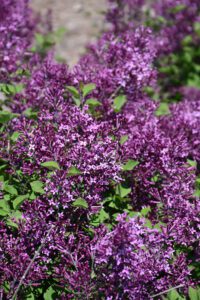May 1, 2025
Fragrant Favorites: A Guide to Growing and Enjoying Lilacs
Few plants capture the magic of spring like lilacs. Their sweet, nostalgic scent often brings back memories of home or garden strolls from seasons past. For many, the blooming of lilacs signals that summer is just around the corner.
Growing Lilacs: Tips for Success
☀️ Sunlight
- Full sun (6+ hours a day) is essential for strong flowering.
? Soil
- Lilacs thrive in well-drained soil. If your soil is heavy or clay-based, improve drainage by adding compost and gypsum.
- They also prefer a sweet soil with a PH between 6.5 and 7 and will benefit from a handful of lime worked into the soil at the base of the plant each fall.
? Air Circulation
- Space plants to allow for airflow—this helps prevent powdery mildew on foliage.
✂️ Pruning & Deadheading
- Prune right after flowering, ideally by early July, to avoid cutting off next year’s blooms.
- Deadhead spent flower clusters to encourage future flowering and maintain shape.
Where to Plant Lilacs
- Near patios or windows, where their fragrance can drift indoors
- As part of a mixed border with peonies and roses
- In a hedge for privacy and scent
How to Cut Lilacs for Arrangements
- Lilacs make beautiful, fragrant cut flowers. Harvest panicles when ¼ to ½ open. Split the bottom of each woody stem 1–2 inches with pruners for better water uptake—no need to crush the stems.
? Lilac Varieties to Love

Syringa x hyacinthiflora ‘Pocahontas’
Syringa x hyacinthiflora ‘Pocahontas’
Deep reddish-purple blooms appear early in the season, filling the garden with fragrance. Mildew-resistant and upright, growing 8–10’ tall.
Syringa vulgaris ‘Double Blue’
Lavender-blue, double blooms shimmer in the spring light. This strongly fragrant, upright grower matures around 8–12’ tall.
Syringa vulgaris ‘French Sensation’
Bi-colored blooms—purple petals edged in white—give this French hybrid a unique flair. Grows 8–10’ tall, with sweet fragrance and classic charm.
Syringa vulgaris ‘French Moscow Beauty’
Also called ‘Krasavitsa Moskvy’, this heirloom variety features lush double flowers in blush pink and white. Height: 8–12’.
Syringa vulgaris ‘New Age Lavender’
Full-sized lilac blooms on a compact, mildew-resistant shrub. Lavender flowers on a 4–5’ tall and wide plant.

Syringa vulgaris ‘New Age White’
Syringa vulgaris ‘New Age White’
Same compact size and mildew resistance as ‘New Age Lavender,’ but with clean white blooms.
Syringa patula ‘Miss Kim’ (Miss Kim Dwarf)
Highly fragrant, lavender-blue flowers bloom slightly later than most lilacs. Fall foliage turns burgundy. Grows 4–7’ tall.
Syringa meyeri ‘Palibin’ (Korean Dwarf Lilac)
Petite purple blooms on a dense, round shrub (4–5’ tall). Excellent mildew resistance and great for borders or foundation plantings.
Our smallest lilac, just 3’ tall and wide! Glossy foliage, compact form, and all the fragrance of a larger lilac. Perfect for containers and small landscapes.

Syringa x ‘Bloomerang Dark Purple’
Syringa x hyacinthiflora ‘Declaration’
Introduced by the U.S. National Arboretum, ‘Declaration’ features reddish-purple blooms up to 12” long. Fragrant and compact at 6–8’ tall.
Syringa x ‘Bloomerang Dark Purple’
A favorite rebloomer! Deep purple buds open to richly scented lavender-purple flowers in spring, then again through summer and fall. Grows 4–6’.
Final Thoughts
Lilacs are more than just beautiful shrubs—they’re emotional touchstones, garden anchors, and the stars of spring. Whether you’re drawn to heirloom varieties or compact rebloomers, there’s a lilac to suit every garden. Come visit us at any of our 7 locations and take a look!


